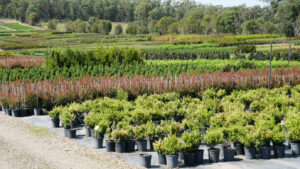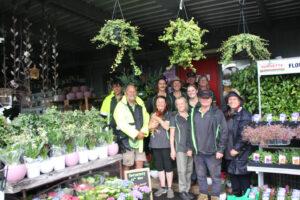
Vocational training: Where are we? How did we get here?
By John Fitzsimmons
Is your enterprise short of people? Is it hard to find the right people? Are the people now on board suitably trained and skilled for real everyday tasks? Whatever your situation, it’s probably the system making the solutions challenging.
Both facts and anecdote suggest our industry is short of people and good people are hard to find. The pandemic aside, where are we and how did we get here?
First a situation report. In Greenlife Industry Australia’s (GIA) December 2021 report, President Glenn Fenton said “Labour shortages are a consistent issue raised by several businesses. It is not expected that this issue will be resolved until international borders are fully opened…”
While Australia’s (April 2022) unemployment rate stood at a 50-year low of 3.9%, it is expected to decline further to 3.5% in early 2023. This is attributed largely to the pandemic, as border closures and uncertainty caused some of our workforce to leave the country, while ‘soaring’ debt levels fuelled a rapid rebound. Some GIA-recommended strategies to consider, in helping your business boost or at least maintain cashflow, include increasing wages or providing extra benefits to retain existing staff.
Pre-pandemic, the Australian government asked ‘What occupations in your industry, sector or business are in demand and/or hard to fill?’ GIA’s response nominated ‘Nurseryperson’ and ‘Nursery Assistant.’ Levy-funded research (Nursery Industry Statistics 2017-18 to 2019-20 NY17008) reported qualified horticulturists are estimated to represent 17% of the greenlife production workforce. The report also highlighted an aging workforce, with 85% of the workforce over the age of 40 years (40-59 years 49%) and (60+ 36%), with the remaining 15% of the workforce below the age of 39.
It was concluded the need for the industry to attract, train and retain Nurserypersons and Nursery Assistants is paramount to the future of the industry.
The Job Outlook government website showed a five-year trend to 2019 for those working in the Nurseryperson’s role (ANZSCO job ID 3624) as falling from 4200 in 2014 to 2600 in 2019, with that trend expected to continue into 2021. Statistics suggested the same over a five-year trend to 2019 for Garden and Nursery Labourers (ANZSCO job ID 8414), from 35,700 to 32,600.
There was also a need identified for nursery professionals (Certificate III Nursery Operations) to be attracted to the industry. However, this needed inclusion in the Australian Government – Australian Apprenticeships National Skills Needs List to boost the industry’s profile, get school leavers and career changers to take on apprenticeships and grow the workforce in the age bracket of 25–39.

The research (and a resulting submission to government) also pointed out that (pre-COVID) about 1650 production nursery growers (essentially crop farmers of plant stock) are not represented under the ANSCO classifications, except under a vague ‘other’ category.
Production nursery growers could be added to the Unit Group 1212 Crop Farmers as a specialisation. This category already includes Flower Growers, Turf Growers, and Vegetable Growers, so seems right place to add another specialisation, it added.
ANZSCO does not represent roles in the industry at a Certificate IV or above and thus GIA submitted this be included under the Unit Group 1212 for a provision of Production Nursery Growers.
So, in the vernacular, you need to be a Philadelphia lawyer to just identify, formally recognise, and clarify(?) the jobs done and skills needed.
In building the associated education and training processes, the political aim has often been just getting people into a job, not developing professional skills or standards.
Australian Education Union Federal TAFE Secretary and General Secretary of the New South Wales Teachers Federation (which includes TAFE teachers), Maxine Sharkey, has long term experience of the systems that we have today. While her background is not in horticulture, she was a TAFE teacher, then a union officer looking after TAFE teachers. She was closely involved with the national Stop TAFE Cuts campaign that ran for over 9 years. So, she has a 20 years-plus, Australia-wide overview of the problems in TAFE and a more in-depth knowledge of the system in NSW.
“I’ve seen the whole system change dramatically and I’ve seen ideas come and go,” Maxine said.
“We are where we are right now, and my union predicted it many years ago, with an industry-wide skills shortage. We foresaw it would be first felt in smaller industries, less financially influential industries, and in regions. And that’s exactly what’s happened.
“In the early 2000s after Victoria’s TAFE system had been “run into the ground”, the same tertiary education advisors became national advisors. This was the start of a ‘contestable funding’ model,” Maxine recalled.
“This was a model whereby all training providers are seen as equal whether you are the public system, which has an obligation to provide for the breadth of industry and for the whole country including far flung places, whether you are the national TAFE system, or a small for-profit, one-person provider working out of your car boot offering on-the-job training. All had the same right to ‘contest’ for the same dollar.
“They priced courses and told us it would be ‘this much money’ to, for instance, run particular courses. If you wanted to run a course, that was the price you had to charge students.
“That change in funding came hand-in-hand with the VET-help* system. So, students were paying more, the public provider/s were getting less, and around the country, TAFE colleges had to make decisions about their survival. When you don’t have enough money to pay the wages of your teachers, how do you continue offering courses?” Maxine commented.

“In NSW, not being able to afford to run them, we cancelled courses, we sacked TAFE teachers. In 2012 there were 17,100 TAFE teachers in NSW, in 2022, 10 years later, there are just 8000! How can you deliver the same level of courses with half the workers?
“One “answer” to that was ‘go online’ but compare 15 people on-site with one teacher for half a day learning the job, with online, where you can have 115 people online for 2 hours”, Maxine observed. “What suffers is the students’ learning and their motivation. You might start with 115 and end up with the same 15 that you would have had, if you enrolled them the old-fashioned way.
“Not long ago in NSW, many TAFE teachers were told ‘you are not competent’, ‘you don’t have the qualification … you can’t teach it.’ That was how they got rid of a whole lot of teachers,” she said.
“Collectively, this was such a waste and loss of skill, experience and talent … lost to the country and the economy.
“Around the country politicians in their wisdom decided that you didn’t need to have a teaching qualification to impart that technical knowledge. All you needed was a Cert. IV.
“Regardless of what anyone thinks of the quality of that, it was then ‘qualification for sale.’ A lot of people made a bit of money out of that. ANY person or company could become a training provider and provide a (horti) qualification to anyone.”
In making funding for vocational education and training ‘contestable’, they created a new ‘market’ where everyone could jump in and look for a different way of making money, Maxine believes.
“That’s where the government money went to. Rather than the government providing a highly regulated and respected series of qualifications to post-school leavers, there was just a proliferation of carpetbaggers!
“When governments realised there was this proliferation of providers putting their hand out, they tried to limit the amount of money they spent and invented VET Fee help and the rort extended!
“The provider got the money. The student was never provided with (quality) learning.
“You could sign up online but there was nothing to motivate you, nothing to keep you going online. In fact, the more people who dropped out the better. It was, [the companies making money out of it] they didn’t even have to hire a qualified person on the other side of the computer screen.”
So, VET Fee Help regulations were tightened up. There’s a whole generation of people for whom that’s their experience of vocational education and training. Those people were burnt and they lost their motivation and interest, according to Maxine.

“The government also decided that we should have training packages and they set up ‘skills expert groups.’ The name changes but it’s supposed to be a group of experts in that particular field, e.g., horticulture, and that included industry (to say) ‘we want these skills, we want people to come out of vocational training with these particular skills, I want you to work if you can do this.’ The training packages were written accordingly.
“So, when I hear ‘industry’ talking about people in the TAFE system not learning the skills that we need, well, you’re the one’s who decided what they were going to learn. “Teachers are not considered ‘experts’ in that field. Teachers are not in the groups that decide what is going to be taught to that cohort of students.
“It is made very clear ‘the assessment must be this, you must assess this and, in this way.’ Not too many teachers believe that is actually teaching the skills that people require in whatever industry it’s in.”
Box ticking? “Very much so.”
“Now, because we weren’t skilling our own people, we’ve been importing people with those skills. Nobody noticed that our industries were going to fall down, then COVID happened and everyone went ‘oh my goodness, I can’t get (staff or services)’.
“It all comes back to the idea of governments trying to create a market. Ideologically, they felt that government should not be involved in skills training – it should go to the private market. Governments got out of their earlier obligations.”, Maxine explained.
“We’ve lost teachers who had the knowledge and who understood the qualification intimately, were able to assess people, individually and collectively, and say ‘you have the knowledge and have demonstrated the necessary skills’,” she commented.
Maxine notes that what governments of all persuasions have done serially, both Federal and State, is say that the teacher does not or should not have the expertise to be able do that, but a company can do it!
“But government ideologies said those people couldn’t be trusted. In fact, you will find quotes that when training packages were started, they were to be written in such a way as to be ‘teacher proof,’ so it wouldn’t matter which teacher was ‘delivering’ the course. Teachers don’t teach, they stand in a room and deliver the training package/s.
The inference is that vested interests have bought in, and have been influencing, if not steering the system under the guise of being ‘the industry.’
“Industries are screaming out that the qualifications aren’t what they want, yet the qualifications were handed over to industry, but industry was taken over by large industry and big business, rather than what used to be the main employer of TAFE students, smaller ‘mum and dad employers’, e.g., the local greenkeeper who would put an apprentice through TAFE. Those employers are saying ‘we’re not getting what we want out of TAFE.’ ‘Industry’, is now the big players who are less interested in what’s happening in horticulture or parks & gardens in regional Australia,” Maxine summarised.
This is not the fault of the teachers or the TAFE’s. It’s the fault of the system that governments have set up, that they are not ‘industry’, that the smaller employers are not being recognised as ‘industry.’
Perhaps it is pertinent there is no individual nominated on GIA’s website tasked with training, education or like issues.
(*VET Fee-Help. VET (Vocational Education & Training) Student Loans was a loan scheme to assist eligible, full fee-paying students studying an approved vocational education and training (VET) qualification to pay their tuition fees. VET Student Loans replaced VET Fee-Help from 1 January 2017. A HECS-Help loan is only available to those enrolled in a Commonwealth Supported Place (CSP), whereas FEE-Help is a loan for eligible domestic fee-paying students studying any type of course at an approved provider.)
